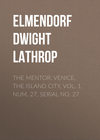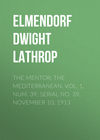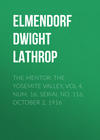Loe raamatut: «The Mentor: Egypt, The Land of Mystery, Serial No. 42»
EGYPT, THE LAND OF MYSTERY
By DWIGHT L. ELMENDORF
THE MENTOR · SERIAL NUMBER 42
DEPARTMENT OF TRAVEL
◆
It is no wonder that the Egyptians through all their history have worshiped the Nile; for that marvelous river is the spine, the marrow, and the life of Egypt. Indeed, it is Egypt; for living Egypt is only a narrow strip twelve or fifteen miles wide, – simply the banks of the Nile. Herodotus called Egypt "the gift of the Nile." The river nourishes and controls the land. All along that waterway are to be found wonders and mysteries of the past. The mind balks in contemplation of the monuments of Egypt. They whisper messages from so far distant a time that we stagger in trying to grasp their meaning.
A visit through Egypt usually begins with Cairo. And it is just as well that it is so; for in Cairo there is much that is modern and much that is familiar to the English traveler. It is, therefore, a good way for the visitor to break into ancient Egypt. In Cairo modern people mingle with the sons of ancient Egyptians. The English soldier is to be seen almost everywhere, and in front of Shepheard's Hotel you may at times almost forget that you are in Egypt.
That is because you are bound down in Cairo, mingling with your own fellow visitors and too close to hotel life. Get up early in the morning, and go to the top of the hill known as the Citadel, and there you will get an impression of an Egyptian city. Look at one of the greatest buildings, the Mosque of Mehemet Ali. It is called the Alabaster Mosque. There is a great deal in modern Egypt that is imitation. That is the reason that this building of pure alabaster is to be valued. Its interior is rich and beautiful in design.
CAIRO AND ITS SURROUNDINGS
Stand on the parapet of the Citadel, and look over Cairo, and see the sun rise. Far in the distance is a sandstorm. Many people in the United States think that the weather in Egypt is as clear as crystal always. That is a great mistake. The days there are rarely as clear as American clear days. In January, February, and March you are likely to have sandstorms, or the sirocco, or wind from the desert, which almost obliterate the sun.
Down by the edge of the desert is the Dead City. The tombs there and their interiors are wonderful. The beautiful buildings have been allowed to decay. It is an oriental peculiarity not to repair anything.
On the other side of the Citadel are the tombs of the Mamelukes. I advise anyone going to Cairo to visit these tombs; for they contain very curious sarcophagi, and the tomb mosques are interesting, each of them being surmounted by a picturesque dome.
Our modern expositions and fair grounds would not be complete without "the streets of Cairo." As we know, a bit of street life is shown, more or less accurately – chiefly less. A fairly correct impression of Egyptian street life is, however, created by such artificial reproductions. One of our pictures will no doubt recall these exposition impressions. The genuine old streets of Cairo are fascinating. Some are so narrow that the traveler must go on foot, or on a donkey. The shops are almost within arm's reach on both sides, and many of them are temptingly attractive. There on one side they make famous leather goods; on another they sell glassware. Be careful not to buy unless you know how to bargain.
THE STREETS OF CAIRO
You must go to these little streets to find the bazaars if you want to buy anything; for the great street of the Arab quarter, the famous Muski, is not any longer a thorough Cairo street. Big shops and department stores have crept into it.
Stand for a moment on the corner of this great street and see a little bit of the Arab life of old Cairo. It is a busy city. There goes a carryall (a camel), an entire family on its back, except the husband, who walks by the side. This man coming down with a strange sack on his back is a walking fountain. The sack is filled with something sweet and sticky which he calls "sweet water." It is not pleasant. The genuine water carrier of the old school goes to the river, fills his jar, and then goes through the streets shaking his cup in his hand with a chink. It is plain water that he peddles. I should not advise one to drink either of these beverages. Then there are the bread venders of Cairo, who walk the streets carrying bread on their heads and crying out their wares.
Cairo is full of interesting mosques. The oldest and most celebrated is the Mosque of Omri. It is one of the earliest of Mohammedan temples in Egypt. They have a service there but once a year, when the khedive himself comes. The interior seems a veritable forest of pillars. One of these is a most remarkable pillar. I will tell the story of it as my boy Mohammed Mousa told it to me: "This pillar very important one – very holy. This pillar sent by Mahomet here; for when Omri come to build this mosque Mahomet so pleased he sent pillar from Mecca. The pillar come here. He find no other pillar from Mecca here; so he get lonely and fly back. Mahomet very angry, and send pillar back. Second time he fly back. Mahomet then get very angry, draw his sword, and strike pillar, and tell Omri to put pillar in prison. So he put it in prison, and it stand there." That is the story that they all believe.
















